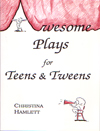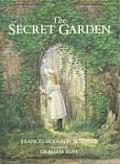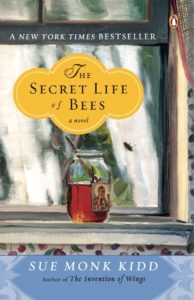 Here are a few reviews of Christina Hamlett’s Awesome Plays for Teens and Tweens sent in by moms.
Here are a few reviews of Christina Hamlett’s Awesome Plays for Teens and Tweens sent in by moms.
Our mother and daughter club usually reads novels—new releases and classics—but when one of our younger members asked if we could read some plays out loud, this was something brand new for us. Most of us have been to theater performances but weren’t familiar with what a play looks like on the page. The anthology we read is Awesome Plays for Teens and Tweens by Christina Hamlett and we’re now completely hooked!
This is a collection of 15 one-act comedies and each one is short enough that we could read several of them in each meeting. It was great fun to assign roles to one another, plus this experience was invaluable in terms of encouraging our daughters to speak clearly, enunciate, experiment with different accents…and not trample on each other’s lines! It was also a wonderful spotlight on our young actress in the group who led discussions afterwards about what it’s like to be in a play.
Although we liked all of the plays in this book, my own favorites were “Cyrano de Cinema” (it very much has a “Hollywood” style to it), “A Bard of Brothers” (which reminded all of us of the kind of snappy writing in “Frasier”) and “The Knight of the Honest Heart” and its sequel, “The Knight of the Honest Heart Returns”. Last but not least, the girls all loved “Lessons of Oz” which is a humorous take on what happens when Dorothy comes back and becomes a best selling author but her pals from Oz aren’t so happy with the gifts they received. With “Lessons of Oz” fresh in our heads now, we’re thinking of going as a group to see “Wicked” when it plays here. I recommend playreading to mother and daughter clubs who are looking for something fresh and fun to do and Awesome Plays for Teens and Tweens is a great introduction to the world of the theater.—Inez C., Arizona
It is truly remarkable that one author, Christina Hamlett, wrote all fifteen plays in Awesome Plays for Teens and Tweens. From fairytale forests to haunted houses, from southern belles to regal royalty—this book has it all. One of my favorites, “The Knight of the Honest Heart,” is set in England during the Middle Ages. This romantic tale of deception and mistaken identity pairs Sir Crispin and Lady Elaine in an odd, yet sweet, amusing courtship.
Another favorite, “Lessons of Oz”, is about a modern day Dorothy (Ozborne), a temperamental, celebrated author, and her uptight literary agent, Zelda Blabbich. The Scarecrow, Tinman and Cowardly Lion all show up for Dorothy’s book signing of “Kansas Never Looked So Good.” Turns out, since they returned from Oz, they are all miserable. Dorothy realizes that fame isn’t all it’s cracked up to be. The message is clear—be careful what you wish for!
“Tales of the Tangled Tresses” tells the story of Goldilocks, Rapunzel, Cinderella, Briar Rose, and Alice from Alice in Wonderland at the Fabulous Frills Hair Salon. Alice is, of course, late for her appointment; Rapunzel feels fifty pounds lighter after her trim and wants to donate to Locks of Love (the organization that makes wigs for kids who have lost their hair because of illness); and poor paranoid Goldilocks needs a dye-job to conceal her identity after being chased by the cops.
I sure wish my theatre teacher had this book for our theatre company back in the day. The book is available directly from www.playsmagazine.com. (On the Amazon site, it says that it’s out of stock/unavailable and that could be misleading to theater groups who want to purchase it). Filled with funny surprising plot twists, well-developed characters, and many laugh out loud moments—this book is plain old fashioned fun! – Marci W., Maui, Hawaii
Christina Hamlett has done it again with another great book for teens. This one is entitled Awesome Plays for Teens and Tweens. This 201 page book is comprised of 15 fun plays that would be wonderful for junior high/high school aged kids. Each play is laid out to take about 15 minutes of stage time and are short enough for beginning actors but fun enough for any level of acting. The plays in this book aren’t your typical, boring, drama-class scripts. Although many of the plays take place in times other than the present, they all touch on current events and are full of the satire that we live with each day.
One of my favorite plays in the book is titled “Lessons of Oz”. This script is written to take place following the original Wizard of Oz and to take a peek into what is happening in the “here and now” of the characters we grew familiar with so long ago. Dorothy has written a book on the adventure she had on her way to Oz. Zelda Blabbich is the well-named, money-hungry, book agent who seems to just blab away on her cell phone, giving lip service to whomever needs it at the moment. We also run into the Lion, Scarecrow, Tinman, the Wicked Witch and even Oz, himself. The script is brilliantly told in a way that expresses the irony of asking for more than we bargained for. Or biting off more than one can chew, if you will. Dorothy writes her book, but the fame is too much for her. The Cowardly Lion has so much courage now that protecting people from danger is all he has time for. The Tinman is depressed because now that he has a heart, he feels how much pain and heartbreak is in the world. And the Scarecrow is bogged down by all his thinking. All he does is think, think, think.
In this book we see Christina’s talents in so many ways. We see her wisdom in the lessons learned in each play. In “The Knight of the Honest Heart” we learn not to pretend we are more than we really are because there is always someone out there that is going to love us just for being ourselves. In “A Loan for Columbus” we read the ever-present lesson of how important it is to help others manifest their dreams. They may seem crazy, but in the end, they can really help out in the world. But don’t think her makeshift Aesop’s Fables are boring and humdrum. Her wit and sense of humor is abundant. Just like in “Lessons of Oz” when the Scarecrow says he’s tired of thinking too much, she lashes back at him by quickly suggesting he apply for a job with the government. Let me tell you, she had me slapping my knee and wishing I was in my tenth grade drama class again.
So for all of you actors and actresses in the making, go get a copy of this book and get to work with your drama buddies. And to the rest of you who are just taking drama because it was better than wood shop, or there is a hot girl you are hoping to write a make-out scene with, go order this book and start practicing “The Shady Lady of Gopher Junction” or “Reversal of Fortune.” I know the Amazon website says that the book isn’t available, but never fret! You can order your copy at www.playsmagazine.com. – Crystal O., Burbank, California














